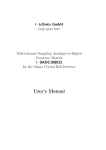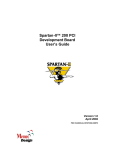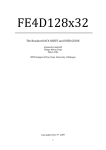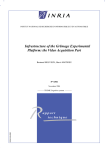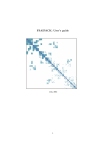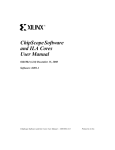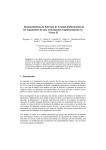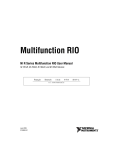Download User's Manual
Transcript
i - trOnics GmbH Multi-channel Sampling Analogue-to-Digital Converter Module i - SADC108032 for the Mainz Crystal Ball Detector User’s Manual This manual was written to guide you in the installation, configuration and operation of the i - SADC108032 multi-channel sampling analogue-to-digital converter module. i - trOnics GmbH excludes completely any liability for any indirect, special, incidental, or consequential damages (including damages for loss of profits, loss of business, loss of use or data, interruption of business and the like) even if i - trOnics GmbH has been advised of the possibility of such damages arising from any defect or error in this manual or product. Information and specifications in this manual are for informational use only. They are subject to change at any time without notice, and should not be construed as a declaration of conformity for this product nor as a commitment by i - trOnics GmbH. i - trOnics GmbH assumes no responsibility or liability for any errors or inaccuracies that may appear in this manual, including the products and software described in it. October 2003, Rev. 0.96 i - trOnics GmbH Erikastrasse 18b D-85521 Hohenbrunn Germany Tel: +49-89-66006899 Fax: +49-89-66000377 Internet: www.i-tronics.net Email: [email protected] for general information [email protected] for sales information c i - trOnics GmbH. All Rights Reserved Copyright 2003 Product warranty or service will not be extended if: (i) the product is repaired, modified or altered, unless such repair, modification or alteration is authorised by i - trOnics; or (ii) the serial number of the product is defaced or missing. Products and corporate names appearing in this manual may or may not be registered trademarks or copyrights of their respective companies, and are used only for identification or explanation and to the owner’s benefit, without intent to infringe. I Contents 1 FCC statements and CE conformity declaration 1 2 Safety information 2 3 Specifications summary 3 4 Scope of supply 4 5 Hardware installation 5 6 Overview 6.1 The board . . . . . . . . . . . . . . . . 6.2 The front-panel and the analogue input 6.3 The VME backplane . . . . . . . . . . 6.4 Data processing and data flow . . . . . . . . . . . . . . . . . . . . . . . . . . . . . . . . . . . . . . . . . . . . . . . . . . . . . . . . . 7 7 9 10 11 7 Data format 14 7.1 Decoding the data . . . . . . . . . . . . . . . . . . . . . . . . 15 8 Configuration and loading 18 8.1 Loading the HL FPGA . . . . . . . . . . . . . . . . . . . . . . 18 8.2 Loading the ZR FPGAs . . . . . . . . . . . . . . . . . . . . . 19 8.3 Configuring the ZR FPGAs . . . . . . . . . . . . . . . . . . . 19 II 1 FCC statements and CE conformity declaration 1 2 Safety information Before starting with the installation of the i - SADC108032 module, please verify that you received the shipment is complete and in perfect condition. Do not try to install modules that have visible defects, it could damage other components. • Always use insulated, antistatic tools and avoid touching the electronic components. • Before using the module in a crate, make sure all cables are connected correctly and the power cables are not damaged. • To prevent electrical shock hazard, disconnect the power from the electrical outlet before relocating the system. • When you add or remove modules from your system, ensure that the crate is switched off and that the power supply cable is out of the socket. • Do not use force when plugging/unplugging modules. • To avoid short circuits keep small conductive parts like screws, clips, and staples away from connectors, slots, sockets and circuitry. • Avoid dust, humidity, and temperature extremes. Do not place the module in any area where it may become wet. 2 3 Specifications summary Form-factor Power inputs VME 6U +5 V/max. 5 A −12 V/max. 0.8 A Power consumption 35 W total +5 V/25 W −12 V/10 W Number of channels 32 ADC resolution 10 bit Sampling rate 40 MHz Noise performance 0.6 LSB RMS (DC input signal) Input impedance 50 Ω Input range -1.25 V to 0.25 V Input signal connector 2 × 34 pin Maximum trigger latency 511 cycles = 12.78 µsec Maximum number of samples/event 128 Depth of multi-hit buffer 4 Number of sample integrals 3 Data bandwidth of optical link 40 MByte/sec Bandwidth for configuration data 40 MBit/sec Maximum length of optical fibre 100 m 3 4 Scope of supply Please check the contents of your package. The scope of supply of a i SADC108032 module includes: • 1 × i - SADC108032 multi-channel sampling ADC VME 6U board • 1 × manual If your package is not complete or is damaged, please contact i - trOnics. 4 5 Hardware installation Attention: • Make sure that you are using a standard VME crate with IEEE-1014 back plane. • Make sure the VME crate has a fan unit which provides sufficient air cooling. Do not operate the module without active cooling. • Make sure that unused slots of the VME crate are closed with metal screens to improve ventilation and electromagnetic emission. • Always use insulated, antistatic tools and avoid touching the electronic components. • Do not install modules with visible defects. • Do not hot-plug modules. • Do not use force to insert/remove modules. • Avoid dust and dirt on the optical fibre connectors. Always use the protection caps for unconnected plugs and jacks. • Carefully read the safety information in chapter 2. Procedure: 1. Switch off the VME crate and pull the power supply cable out of the socket. 2. Carefully insert the i - SADC108032 module in the VME slot and screw the front-panel to the crate. 3. Connect the cables for the analogue signals. Pin 1 sits in the lower right corner of the 34 pin connector (see subsection 6.2). 4. Reconnect the power supply cable and switch on the crate. 5. Make sure that the rightmost FPGA LED on the front-panel is lit (see subsection 6.2). If this is not the case the PROM for the HL FPGA has to be loaded (see subsection 8.1). 5 6. Setup and load the i - MUX module to which the i - SADC will be connected to. 7. Connect the fibre from the i - MUX module to the optical transceiver. The optical cable used must be crossed so that the transmitter (Tx) of the i - MUX transceiver is connected with the receiver (Rx) of the i - SADC module and vice versa. 8. Make sure that the ’Clk’ LED on the front-panel (see subsection 6.2) is lit to indicate that the optical link was established successfully. 9. Check that the ’Syn’ LED on the front-panel (see subsection 6.2) is active indicating that the clock recovery chip is active. 10. Load the ZR FPGAs (see subsection 8.2). 11. Set the configuration parameters of the ZR FPGAs (see subsection 8.3). 6 6 6.1 Overview The board The i - SADC108032 module is made according to the 6U VME mechanical standard. A schematic is shown in figure 1. Two 34 pin flat cable connectors bring the analogue differential signals to the 32 Analog Devices AD9214-80 analogue-to-digital converters. The digital samples are read by two Xilinx XC2V1000 FPGAs named ’ZR0’ and ’ZR1’. The ZR chips perform the digital data processing (latency compensation, buffering, zero suppression, data formatting) and each of them is connected to 16 channels: ZR0 to input channels 0 to 15, ZR1 to input channels 16 to 31. The data go from the ZR chips over 16 bit wide links to the so called ’HL’ chip. This Xilinx XCV100E FPGA multiplexes the data from the ZR FPGAs and writes them out to the HOTLink Transmitter which serialises and encodes the data so that they can be sent over the optical transceiver to the destination module. The HL chip also provides the interface to load and configure the two ZR FPGAs. The IEEE-1014 back plane of the VME crate is only used to provide +5 V and −12 V power. 7 Top side VME P1 Clock recovery chip Optical transceiver HotLink transmitter Xilinx XC2V1000 Molex connector for PROM programming ZR Xilinx XC18V02VQ44 PROM Analogue Input Ch 31...16 Fuse –12 V Fuse +5 V Xilinx XCV100E HL Xilinx XC2V1000 Analogue Input Ch 15...0 ZR Zero delay buffers for clock fan-out 16x AD9214 ADC Figure 1: Board schematic 8 VME P2 6.2 The front-panel and the analogue input Clk Syn Tx Rx Com Ack I2C FPGA Tr Rs FF CHANNELS 16-31 CHANNELS 0 -15 The front-panel of the i - SADC108032 module is shown in figure 2 has three connectors: the LCTM1 connector of the optical link and the two flat cable connectors for the analogue differential input signals. The pin assignment of the 34 pin input flat cable connectors and the termination circuitry is shown in figure 3. If one looks into the connector pin 1 is in the lower right corner. The upmost two pins 33 and 34 are connected to the analogue ground. The analogue differential input lines are terminated with 50 Ω and have an input range of −1.25 V to 0.25 V. Furthermore there are ten LEDs. The two LEDs above the optical transceiver indicate the status of the optical link and should be always on during normal operation. The ’Clk’ LED is lit when the fibre connection with the destination module was established successfully. The ’Syn’ LED indicates that the clock recovery chip is active. The two LEDs below the LCTM connector indicate the activity on the configuration bus that connects the HL FPGA with the ZR chips. The ’Com’ LED indicates the activity on the data line. The ’Ack’ LED shows the successful transmission of data packets. Further below three LEDs display the loading status of the three FPGAs. The left LED is for the ZR0 chip, the middle one for ZR1 and the right one for the HL FPGA. During normal operation all three LEDs should be lit. i - SADC 108032.0 Figure 2: Front-panel Figure 3: Analogue input connector pin-out The last row of LEDs shows activity relevant for data taking. The left ’Tr’ LED blinks when triggers are coming in. The middle ’Rs’ LED shows the reset pulses and the ’FF’ LED on the right side indicates overflows in the multi-hit buffer due to too high trigger and/or data rate. The ’FF’ LED should be always off. 1 LCTM is a trademark of Lucent 9 6.3 The VME backplane The VME P1 and P2 connectors are only used for power connections. The i SADC108032 module needs approximately 25 W on the +5 V line and 10 W on the −12V line. Make sure that the power supply of your VME crate is able to provide enough power for all inserted modules. For connector pin-out see tables 1 and 2. A1 A2 A3 A4 A5 A6 A7 A8 A9 A10 A11 A12 A13 A14 A15 A16 A17 A18 A19 A20 A21 A22 A23 A24 A25 A26 A27 A28 A29 A30 A31 A32 – – – – – – – – GND – – – – – – – – – – – – – – – – – – – – – −12 V +5 V B1 B2 B3 B4 B5 B6 B7 B8 B9 B10 B11 B12 B13 B14 B15 B16 B17 B18 B19 B20 B21 B22 B23 B24 B25 B26 B27 B28 B29 B30 B31 B32 – – – – – – – – – – – – – – – – – – – GND – – GND – – – – – – – – +5 V C1 C2 C3 C4 C5 C6 C7 C8 C9 C10 C11 C12 C13 C14 C15 C16 C17 C18 C19 C20 C21 C22 C23 C24 C25 C26 C27 C28 C29 C30 C31 C32 – – – – – – – – GND – – – – – – – – – – – – – – – – – – – – – +12 V +5 V Table 1: VME backplane P1 connector pin-out 10 A1 A2 A3 A4 A5 A6 A7 A8 A9 A10 A11 A12 A13 A14 A15 A16 A17 A18 A19 A20 A21 A22 A23 A24 A25 A26 A27 A28 A29 A30 A31 A32 reserved reserved – reserved reserved reserved reserved reserved reserved reserved reserved reserved reserved reserved reserved reserved reserved reserved reserved reserved reserved reserved GND reserved GND reserved GND reserved GND reserved reserved reserved B1 B2 B3 B4 B5 B6 B7 B8 B9 B10 B11 B12 B13 B14 B15 B16 B17 B18 B19 B20 B21 B22 B23 B24 B25 B26 B27 B28 B29 B30 B31 B32 +5 V GND – – – – – – – – – GND +5 V – – – – – – – – GND – – – – – – – – GND +5 V C1 C2 C3 C4 C5 C6 C7 C8 C9 C10 C11 C12 C13 C14 C15 C16 C17 C18 C19 C20 C21 C22 C23 C24 C25 C26 C27 C28 C29 C30 C31 C32 reserved reserved reserved reserved reserved reserved reserved reserved reserved reserved reserved reserved reserved reserved reserved reserved reserved reserved reserved GND reserved reserved reserved GND reserved GND reserved GND reserved reserved reserved reserved Table 2: VME backplane P2 connector pin-out 6.4 Data processing and data flow Figure 4 shows the flow of the ADC data on the board level. The data of ADC 0 to ADC 15 are going to the ZR0 FPGA, the data of ADC 16 to ADC 31 to the ZR1 FPGA. The ZR chips perform all the signal processing and data formatting and write their results via a 16 bit wide link to the HL FPGA. This chip multiplexes the data blocks from the two ZR FPGAs and sends them out to the HOTLink serializer from where they go to the optical transceiver. All elements on the board are working synchronous to the clock signal which 11 is recovered from the incoming serial data stream of the optical transceiver. Analogue differential signals from detectors Optical transceiver HotLink Transmitter 16 x (10 bit, 400 Mbit/sec) ADC 23 Channel 16 - 31 ZR1 FPGA . . . 16 bit, 640 Mbit/sec ADC 16 HL FPGA 8 bit, 320 Mbit/sec ADC 7 Channel 0 - 15 ZR0 FPGA . . . ADC 0 640 Mbit/sec, 16 bit 16 x (10 bit, 400 Mbit/sec) Figure 4: Flow of ADC data Figure 5 shows the block diagram of the ZR FPGA. The 32 ADCs continuously digitise the incoming analogue signals. Each ZR FPGA buffers the sixteen 10 bit wide data streams in a shift register with user controllable depth. This allows to delay the ADC data and thus to compensate the trigger latency. When the trigger pulse arrives a configurable number of samples is written into the multi-hit buffer, which can store the data of maximum four events. The number of samples per event is always constant and two events cannot overlap. If two trigger pulses are closer than the sampling window the ZR chips memorise that there was a trigger pulse and start writing the data of the second event right after the first one was finished. This means that in the sparse mode the minimum distance between two triggers is defined by the number of samples taken per event, because for shorter distances the time correlation of the signal in respect to the trigger in the data is lost. 12 ADC data, 16 x (10 bit, 400 Mbit/sec) Trigger Address Latency compensator Multi-hit buffer Sample data 10 bit, 400 Mbit/sec I2C bus from HL FPGA Multiplexer and output interface Zero suppression and formatter Interface to HL FPGA 16 bit, 640 Mbit/sec Formatted data 32 bit, 1280 Mbit/sec Configuration Figure 5: Data processing in the ZR FPGA The multi-hit buffer is read by the data processor unit. This unit computes for every event three user configurable sums over the array of samples: the base line integral (integral 0), the signal integral (integral 1) and the integral of the rising part of the signal (integral 2). For each integral the start index and the number of samples that are summed up can be configured independently. To suppress channels that were not hit the data processor unit compares the difference of the signal integral (integral 1) and the base line integral (integral 0) with a threshold value that can be set for each channel individually. If the difference is below threshold the three integrals of the particular channel are not written out in sparse mode. There is only on data processor unit which processes the channels one after the other so that the time needed for an event is a little bit more than sixteen times the sampling time. This time period defines the maximum average trigger rate in sparse mode. In latch-all mode this value is defined by the bandwidth of the optical link. Consult section 8 on how to set the configuration parameters for latency compensation, number of samples, parameters of sample integrals and thresholds. 13 7 Data format The data of the i - SADC108032 module are aligned in 32 bit words. For every event the module generates a data block. This event data block itself consists of two ADC data blocks. Each ADC data block is generated by one ZR FPGA and contains the data of the 16 channels connected to this chip. The ADC data block starts with the ADC header word. The format of the ADC data itself depends on the data mode the i - SADC108032 module was set to. If the module is in latch all mode it sends out for every channel first the ADC sample values followed by the three words for the sample integrals. In sparse mode the module only writes out the words of the three sample integrals for each hit channel. The definition of the ADC header word is shown in table 3. The lower twelve bits contain the local event number from the counter in the ZR FPGA. This number is meant to check the synchronicity with other modules and the global event number. If the maximum local event number of (212 − 1) is reached the counter will wrap around and start counting up from 0. In this way the ’Event number’ field in the header should behave like the lower 12 bits of the global event number. The second twelve bit wide field is the ADC block size which is the number of 32 bit words in the ADC data block including header word, so that the minimum ADC block size is one (the ADC header is sent for every event). The bit at position 24 is the mode flag ’M’. If this bit is set to ’0’ the data have latch-all format. If the bit reads ’1’ the data are sparsified (zero-suppressed). At position 25 sits the overflow flag ’O’. This bit indicates whether there was an overflow of the multi-hit buffer in the ZR FPGA due to a too high incoming trigger rate. This is also indicated by the ’FF’ LED on the frontpanel (see subsection 6.2). If the ’O’ bit is set data are probably not valid, because the ZR FPGA took the data with an unknown time offset with respect to the trigger. The last field in the ADC header is the 4 bit wide ADC ID. This ID serves to distinguish the different ZR FPGAs (and thus the connected channels) that are multiplexed by the i - MUX module. The i - MUX module series can multiplex the data of up to eight i - SADC108032 modules. With each ADC module having two ZR FPGAs this gives maximum 16 different IDs from 0 to 15. In latch-all mode the header is followed by the words of the ADC sample data of the channel 0. Table 4 shows the format of these words. Each ADC sample word consists of three consecutive ten bit wide ADC values in ascending order 14 31 20 10 0 ADC header 10 ID (4) O M ADC block size (12) Event number (12) Table 3: Definition of the ADC header. with the first sample in the low part. The unused samples in the last word of the channel (depending on the configured number of samples per event; see subsection 8.3) are always set to zero. The three ADC sample integral words are generated for every channel in latch-all mode and for every channel above threshold in sparse mode respectively. Their definition is shown in table 4. The two low bytes contain the sample integral itself. If this sum reaches the maximum value it saturates, which means that integral values of 0xFFFF are not valid, because the real value of the sum is unknown. The suppression flag ’S’ at position 23 of the ADC sample integral word is a debugging feature in the latch-all mode where it indicates whether the channel would have been suppressed in the sparse mode (S = 1). This allows to cross-check the zero suppression. The last field of this word is the 4 bit wide channel number. It is needed for the sparse mode, because in this mode only the hit channels are written out. 31 20 10 0 ADC sample data (latch all mode only) 10 Sample 2 (10) Sample 1 (10) Sample 0 (10) ADC sample integral 10 Channel (4) 00 S 0000000 Sample integral (16) Table 4: Definition of the ADC data words. 7.1 Decoding the data The data decoding of the i - SADC108032 module is straight forward. There are two cases to distinguish: the latch-all and the sparse mode. In sparse mode only ADC sample integral words are generated. For each hit channel there are three of these words. So one reads blocks of three words as long as the number of read words is smaller than the ADC block size. 15 In latch-all mode there are in addition the ADC sample words for each channel. They come before the ADC sample integral words. The number of sample words per channel is calculated (block size − 1) divided by the number of channels (= 16) and decreased by the number of sample integral words (= 3). So for each channel one loops over the number of ADC sample words and then reads the three sample integral words like in sparse mode. The following very simple code snippet illustrates the above procedure to encode the data of one ZR FPGA. ... // b i t f i e l d s f o r d e c o d i n g struct a d c h d b i t f i e l d { : 1 2 ; // l o c a l e v e n t number unsigned int e v n r unsigned int b l k s z : 1 2 ; // b l o c k s i z e unsigned int mode : 1; // d a t a mode : ’ 1 ’ s p a r s e , ’ 0 ’ l a t c h a l l unsigned int o v f l : 1; // o v e r f l o w i n m u l t i −h i t b u f f e r unsigned int i d : 4; // ID o f ZR c h i p : 2; // not used ; s h o u l d be ’ 1 0 ’ unsigned int n u }; a d c h d b i t f i e l d ∗ adc hd ; struct a d c d a t a b i t f i e l d { unsigned int v a l 0 : 1 0 ; // sample v a l u e 0 unsigned int v a l 1 : 1 0 ; // sample v a l u e 1 unsigned int v a l 2 : 1 0 ; // sample v a l u e 2 unsigned int n u : 2; // not used ; s h o u l d be ’ 1 0 ’ }; a d c d a t a b i t f i e l d ∗ sample dt ; struct a d c i n t e g r a l b i t f i e l d { unsigned int v a l : 1 6 ; // sample i n t e g r a l v a l u e unsigned int n u 1 : 7 ; // not used ; s h o u l d be 0 unsigned int suppr : 1 ; // s u p p r e s s i o n f l a g unsigned int n u 2 : 2 ; // not used ; s h o u l d be 0 unsigned int c h n r : 4 ; // c h a n n e l number unsigned int n u 3 : 2 ; // not used ; s h o u l d be ’ 1 0 ’ }; adc integral bit field ∗ integral dt ; int i = 0 ; // i n d e x f o r d a t a word a r r a y int adc cnt wd , a d c c n t s a m p l e w d ; // word c o u n t e r s ... // decode ADC h e a d e r adc hd = ( a d c h d b i t f i e l d ∗ ) & data [ i ] ; i ++; a d c c nt w d = 1 ; // h e a d e r i s a l r e a d y read 16 // l o o p o v e r words i n ADC d a t a b l o c k while ( a dc c nt w d < adc hd−>b l k s z ) { i f ( adc hd−>mode == 0) { adc cnt sample wd = 0; // p r o c e s s l a t c h a l l d a t a while ( a d c c n t s a m p l e w d < ( adc hd−>b l k s z − 1 ) / 1 6 − 3 ) { // decode ADC sample d a t a s a m p l e d t = ( a d c d a t a b i t f i e l d ∗ ) & data [ i ] ; i ++; a d c c n t s a m p l e w d++; a d c c nt w d++; } } // p r o c e s s sample i n t e g r a l s f o r ( int j = 0 ; j < 3 ; j ++) { // decode ADC sample i n t e g r a l s i n t e g r a l d t = ( a d c i n t e g r a l b i t f i e l d ∗ ) & data [ i ] ; i ++; a d c c nt w d++; } } ... 17 8 Configuration and loading The FPGAs on the board store their firmware in volatile memories so they loose their programming whenever the power is interrupted. This means the first step of configuring the i - SADC108032 module is loading the FPGAs. 8.1 Loading the HL FPGA The firmware of the HL chip is stored in a Xilinx XC18V02VQ44 EEPROM. The PROM usually contains a valid firmware so that the HL FPGA is automatically programmed at each power up. The successful loading of the FPGA is indicated by the rightmost FPGA LED on the front-panel (see subsection 6.2). If the LED is not lit or the HL firmware has to be updated the content of the PROM has to be rewritten. The PROM has a JTAG interface and to write a firmware file into it a Xilinx Parallel Cable III (or compatible programmer) and the iMPACT software is needed. The Xilinx Parallel Cable III has to be connected to the parallel port of the PC and the Molex plug to the corresponding jack on the i - SADC board (see figure 1). In order to be able to load the PROM the i - SADC module has to be powered at least via the +5 V line. The iMPACT software is part of the ISE WebPACK suite that is available for free for Microsoft Windows 2000 and Windows XP at the Xilinx web site: www. x i l i n x . com/ x l n x / x i l p r o d c a t l a n d i n g p a g e . j s p ? t i t l e =ISE+WebPack The ISE WebPACK suite comes in four flavours. For the PROM programming you need to download and install either the ’Complete’ set or the ’Complete Programming Tools’. To write the PROM file the following procedure can be used: 1. Start the iMPACT software. 2. In the ’Operation Mode Selection’ panel choose ’Configure Devices’ (default). 3. In the ’Configure Devices’ panel choose ’Boundary-Scan Mode’ (default). 4. In the ’Boundary-Scan Mode Selection’ panel choose ’Automatically connect to cable and identify Boundary-Scan chain’ (default). 5. Point to the MCS file you want to load. 18 6. When asked to select the device part name choose ’xc18v02 vq44’. 7. Click the device to select it. 8. Choose ’Program...’ from the ’Operations’ Menu. 9. Check ’Erase Before Programming’, ’Verify’ and ’Load FPGA’. Uncheck all other boxes. 10. Wait until the successful end of the operation is announced. 11. Make sure that the rightmost FPGA LED on the front-panel is lit indicating that the FPGA is programmed. 8.2 Loading the ZR FPGAs The ZR FPGAs are loaded via the optical link and since the HL chip provides the necessary interface this chip has to be loaded beforehand (see subsection 8.1). In normal operation the firmware is transferred by the i - MUX module via the VME bus and the optical link of the i - SADC108032 module. For more detailed description of the i - MUX VME interface consult the i - MUX manual. The successful programming of the ZR FPGAs is indicated by two LEDs on the front-panel (see subsection 6.2). 8.3 Configuring the ZR FPGAs Only when the firmware of all three FPGAs is loaded the configuration registers in the ZR chips can be accessed. Table 5 gives an overview of the different registers and their addresses. The latency register defines how many clock cycles the incoming ADC data are delayed. When set to the minimum value 0 the data are not delayed. The maximum value is 511 which corresponds to a delay of 12.78 µsec. The second register sets the number of samples that are read per event. The maximum allowed value is 128. The register at address 0x1002 is read only and holds the firmware version number of the ZR FPGA. Registers 0x0004 to 0x0009 define the parameters for the three sample integrals that are computed for every event (see subsection 6.4). For each integral one can set the start index of the summation and the number of samples that contribute to the sum. Sample number 0 is the first sample in the event. The last accessible sample is at index (number of samples per event − 1). This 19 Address (13 bits wide) 0x0000 0x0001 0x0002 0x0003 0x0004 0x0005 0x0006 0x0007 0x0008 0x0009 0x0010 0x0011 0x0012 0x0013 0x0014 0x0015 0x0016 0x0017 0x0018 0x0019 0x001A 0x001B 0x001C 0x001D 0x001E 0x001F 0x107F Configuration value Latency in number of clock cycles Number of samples per event Firmware version (read only) Mode of data writing: 0 = latch-all, 1 = sparse Start index of sample integral 0 Number of samples to sum up for integral 0 Start index of sample integral 1 Number of samples to sum up for integral 1 Start index of sample integral 2 Number of samples to sum up for integral 2 Threshold 0 Threshold 1 Threshold 2 Threshold 3 Threshold 4 Threshold 5 Threshold 6 Threshold 7 Threshold 8 Threshold 9 Threshold 10 Threshold 11 Threshold 12 Threshold 13 Threshold 14 Threshold 15 Test register Default value (dec) 1 128 – 0 0 16 0 16 0 16 0 0 0 0 0 0 0 0 0 0 0 0 0 0 0 0 0 Width 9 9 8 1 9 9 9 9 9 9 16 16 16 16 16 16 16 16 16 16 16 16 16 16 16 16 16 Table 5: Address mapping of the internal configuration registers of the ZR FPGA means the start index should always be smaller then the number of samples per event and the number of samples in the sum should be set to an appropriate value so that the integral does not leave the index range. Integral 0 is the baseline integral, integral 1 the signal integral and integral 2 can be assigned freely by the user, for instance as a integral of the rising part of the signal. The threshold registers define the threshold values of the sixteen channels for the zero suppression. If the difference of the signal integral (integral 1) and the baseline integral (integral 0) is below the threshold value the channel is suppressed in sparse mode. For the ZR0 FPGA the threshold number corresponds to the input channel number, for the ZR1 chip the channel number 20 has an offset of 16. The last register is just meant to be used to test the communication between the i - SADC108032 and the connected i - MUX. 21
























